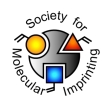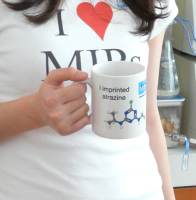
Authors: Zou TB, Zhou ZP, Dai JD, Gao L, Wei X, Li CX, Guan WX, Yan YS
Article Title: Preparation of silica-based surface-imprinted core-shell nanoadsorbents for the selective recognition of sulfamethazine via reverse atom transfer radical precipitation polymerization.
Publication date: 2014
Journal: Journal of Polymer Research
Volume: 21
Issue: (8)
Page numbers: Article No 520.
DOI: 10.1007/s10965-014-0520-6
Abstract: In this work, core-shell-structured silica-based surface molecularly imprinted nanoadsorbents (SMIPs) were prepared using a facile and general method that combined reverse atom transfer radical precipitation polymerization (RATRPP) and a surface imprinting nanotechnique. The resulting nanoadsorbents were then used to improve selective recognition and achieve the rapid removal of sulfamethazine (SMZ) from water. A modified one-step Stöber method was used to prepare monodisperse vinyl-functionalized silica spheres 250 nm in size. Subsequently, an imprinted polymer nanoshell (only 25 nm thick) was uniformly coated onto the surfaces of the hybrid silica spheres in a two-step polymerization process. The characteristics (i.e., isotherms, kinetics, and mechanism) of the adsorption of SMZ onto SMIPs from aqueous solution were systematically studied using batch experiments. The adsorption capacity increased with increasing initial concentration and contact time. The nonlinear Langmuir, Freundlich, and Temkin models were used to analyze equilibrium data, and these data were found to be best represented by the Langmuir isotherm, which yielded a high maximum monolayer adsorption capacity of 76.34 μmol g-1 due to the effective sites located in the thin imprinted nanoshell. The adsorption process rapidly reached equilibrium and the data were best described by a pseudo-second-order rate model. The adsorption mechanism was mainly governed by intraparticle diffusion. The SMIPs adsorbed more SMZ than nonimprinted nanoadsorbents did, and they adsorbed much more of the template than other antibiotics, suggesting that the SMIPs show excellent selective recognition. Reusable SMIPs were shown to be a potentially efficient nanoadsorbent for the selective and fast removal of antibiotic residues from aqueous environments
Template and target information: sulfamethazine, SMZ
Author keywords: Surface-imprinted nanoadsorbents, Sulfamethazine residues, selective recognition, RATRPP, Core-shell structure



Join the Society for Molecular Imprinting

New items RSS feed
Sign-up for e-mail updates:
Choose between receiving an occasional newsletter or more frequent e-mail alerts.
Click here to go to the sign-up page.
Is your name elemental or peptidic? Enter your name and find out by clicking either of the buttons below!
Other products you may like:
 MIPdatabase
MIPdatabase









